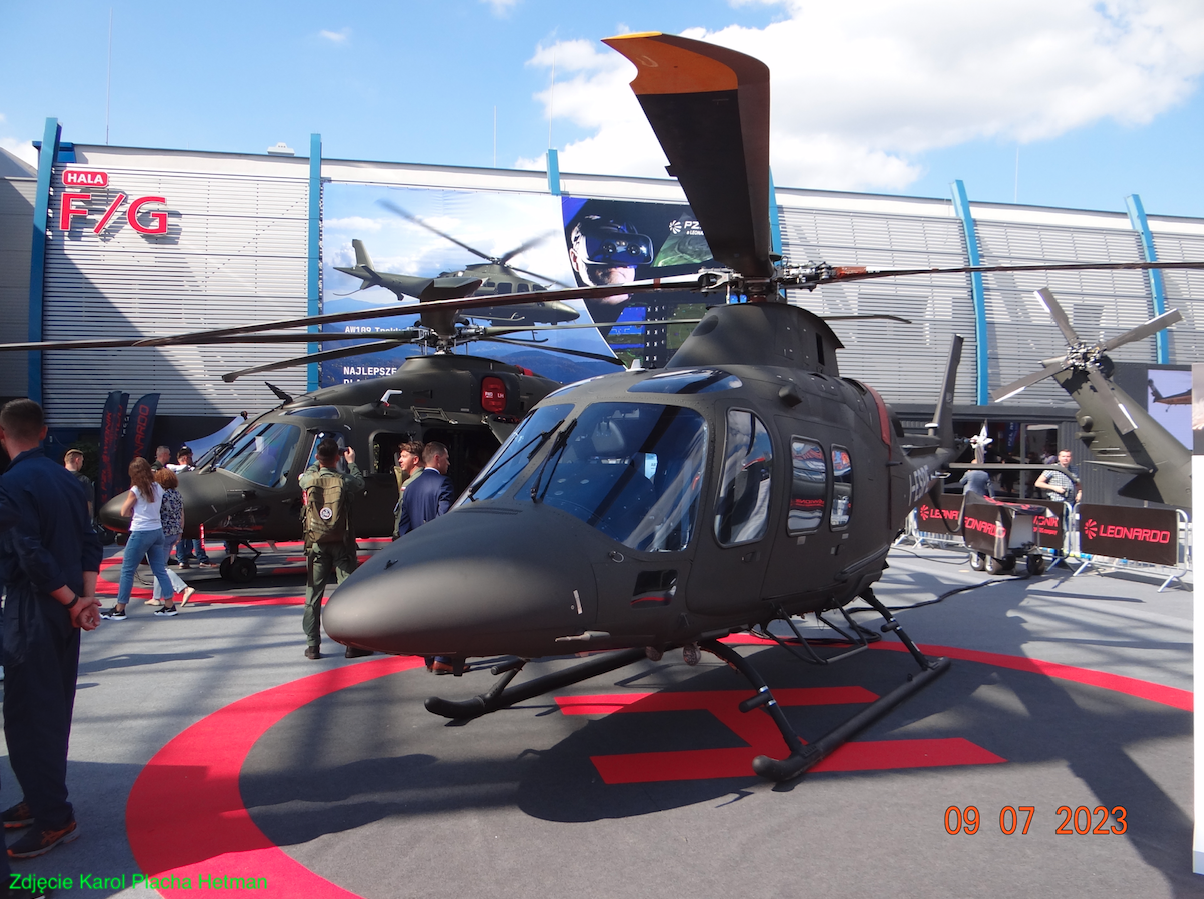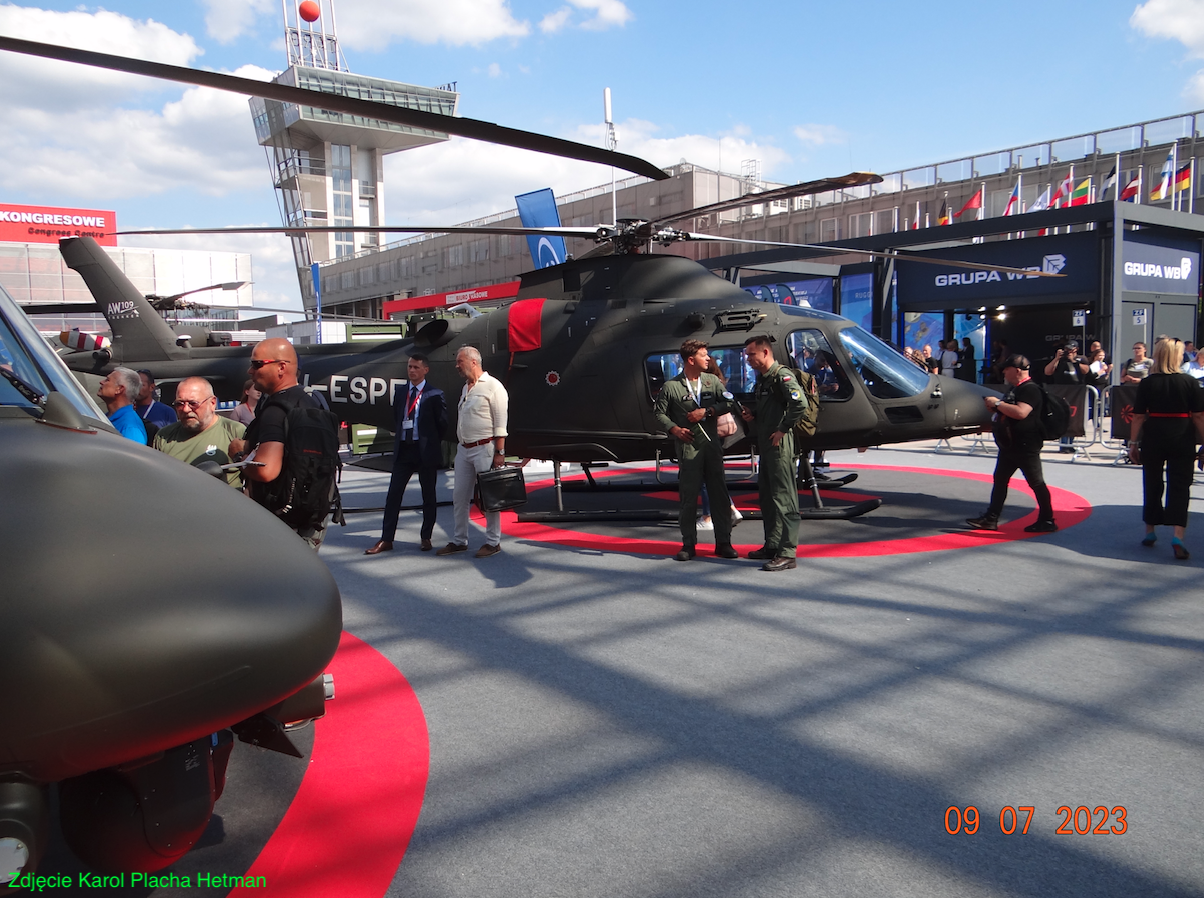Kielce 2023-09-12
PZL Świdnik Agusta AW.109 Trekker.
The AW-109 Trekker helicopter is the next generation of a good multi-role helicopter, the origins of which date back to 1971. On August 4, 1971, the first flight was made by the A-109 helicopter.
The A.109 helicopter is the only in-house design of Agusta, currently (2023) Leonardo. The A.109 nb NC 7101 prototype first flew on August 4, 1971. The helicopter received RAI and FAA certificates on June 1, 1975. At the same time, the A.109 helicopter was approved for instrument flight with a single crew. A few months later, the A.109 helicopter received certificates: France, Canada, Germany, Sweden, Switzerland and the UK.
Agusta offered the A.109 helicopter in the following versions: civilian, land forces and naval aviation. The civilian version of the helicopter was offered as a fast VIP transport, as well as for state services: sanitary, police and border guard.
The first production helicopters were delivered to customers at the beginning of 1976. More than half of helicopter production was exported to the USA. In Italy, A.109 helicopters were delivered to the traffic police and carabinieri. Many helicopters were delivered to Africa and Asia. At the beginning of the 1980s, the A.109 helicopter was modernized. In the following years, the helicopter was modernized to meet the changing needs of customers. The helicopter was and is offered either with a wheeled landing gear, which is retractable, or with a skid landing gear. The A.109 K helicopter is a version intended for the military, adapted to operate in a hot climate. The A.109 K prototype first flew in March 1983. The A.109 X Mk II Widebody helicopter has an enlarged fuselage that is wider. The helicopter made its first flight in September 1984.
In the 1990s, WSK PZL Świdnik, looking for orders in order not to close the plant, concluded an agreement with Agusta in 1996 for the production of structural elements of Agusta A.109 helicopters (currently AgustaWestland AW.109) in Świdnik. The production of helicopter fuselages and tail booms began in Świdnik. In 2006, the 500th A.109 fuselage was delivered from Świdnik. In 2001, the cooperation was extended to include the production of a hull for the Agusta A.119 Koala model (currently AgustaWestland AW.119). Świdnik had a large part in the design and production of the AgustaWestland AW.139. Since 2012, complete hulls for the AW.139 model have been manufactured in Świdnik. At that time, there were also talks about the production of components for the AW.149 helicopter, should its production be undertaken.
AW-109 Trekker.
The AW-109 Trekker helicopter is the next generation of the A-109 helicopter. With best-in-class lifting capacity, the longest reach and excellent performance, the multi-purpose AW-109 Trekker enables operators to tackle even the most demanding tasks. The twin-engine AW-109 Trekker is a flexible, rugged and reliable helicopter that provides a large payload and a spacious cabin that can be quickly reconfigured, making it ideal for a wide range of applications. The AW-109 Trekker helicopter’s largest-in-class payload and performance make it ideal for emergency medical services (EMS) and search and rescue (SAR) missions. Excellent Class 1 Category A performance ensures the helicopter can take off and land safely in confined spaces and can quickly respond to incidents. In the sanitary (medical) version, the spacious cabin allows for efficient care of injured patients on board.
The helicopter uses a glass-cockpit crew cabin from Genesys Aerosystems. The system minimizes the pilot’s workload and increases his situational awareness. Large power reserves of the drive system and full crash resistance maximize safety in all flight conditions.
The English name Trekker means Wanderer. The helicopter design was presented in 2014. The helicopter was presented at HeliExpo 2014 in Anaheim, California, USA. The prototype made its first flight on March 3, 2016. The AW-109 Trekker was certified in 2014 and production began in 2015.
The helicopter is hunted by one or two pilots. The loading bay accommodates up to six passengers or two stretcher patients and three additional people. The helicopter has low vibration and low noise levels, ensuring high comfort for passengers and crew.
In the helicopter’s design, it was decided to use a skid landing gear, which has several important advantages compared to the retractable wheeled landing gear. The design of the new helicopter is based on the AW-109 Grand design. The fuel system has been completely rebuilt and is resistant to accidents and disasters. The helicopter can be equipped with a cargo hook with a lifting capacity of 1,400 kg. You can also install a rescue winch with a capacity of 272 kg. The helicopter can be equipped with: radar, infrared sensors, additional searchlights, rescue floats, optoelectronic heads and others.
The AW-109 Trekker includes a modern Garmin G1000HTM glass cockpit, which is designed to be operated by one pilot. There are two 10.4-inch displays in the cockpit, the primary flight display (PFD) and the multi-function display (MFD).
The ergonomically designed, high-visibility cockpit offers pilots only the data they need, thereby minimizing their workload. The cockpit also offers the option of a third screen, with a diagonal of 10.4 inches, which can serve as the co-pilot’s PFD.
The helicopter is equipped with Synthetic Vision Technology (SVT), Highway In The Sky (HITS) technology and Helicopter Terrain Awareness and Warning System (HTAWS) to provide full awareness of terrain and obstacles in a low visibility flight scenario.
The helicopter has a three-axis autopilot, a moving map, a flight management system (FMS), two VHF/AM radios, dual Very High Frequency OmniRange (VOR), dual global positioning system (GPS), electronic standby instrument system (ESIS) and a Modu transponder S. Three-dimensional guidance and detailed terrain maps provided by the helicopter improve operational capabilities to complete the task.
The helicopter is equipped with a power unit consisting of two Pratt & Whitney Canada PW207C engines. Each turbine engine generates a maximum power of 815 HP. The engines are equipped with Full Authority Digital Engine Control (FADEC).
Data T-T AW-109 Trekker:
Total length 12.96 m 42 ft 06 in. Height 3.60 m 11 ft 09 in. Main rotor diameter 10.83 m 35 ft 06 in. Main rotor diameter 10.83 m 35 ft 06 in. Maximum cruising speed 281 km/h 152 KTAS. Maximum range 833 km 450 nm. Maximum flight time 4 h 20 min. Maximum take-off weight (MTOW) 3,175 kg. Maximum take-off weight (external payload) 3,350 kg. Fuel tank capacity (option 1) 670 liters. Fuel tank capacity (option 2) 806 liters.
Written by Karol Placha Hetman



